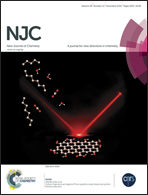An intramolecular hydrogen bond study in some Schiff bases of fulvene: a challenge between the RAHB concept and the σ-skeleton influence
Abstract
The characteristics of intramolecular hydrogen bonds (IHBs) of some substituted derivatives of hydroxyl Schiff bases of fulvene have been investigated. For this purpose, the quantum mechanical calculations using density functional theory at the B3LYP/6-311++G(d,p) level of theory, and also natural bond orbitals and atoms in molecules analyses have been employed. Investigations into some aromaticity indicators (HOMA and pEDA) confirm that aromaticity and electron delocalization in the IHB quasi-ring of 3-hydroxy-2-((methylimino)methyl)fulvene derivatives increase by increasing the electron-donating character of substituents. Unexpectedly, the IHB strength decreases with an increase in the π-electron delocalization in the quasi-ring of these fulvene derivatives. According to this study, at least for this series of compounds, the resonance-assisted hydrogen bond (RAHB) concept could not explain the trend of the IHB strength. Alternatively, we present a good correlation between the IHB strength and the σ-skeleton of the studied molecules, which keeps the HB donor and the HB acceptor coplanar and closer to each other to form stronger IHBs.


 Please wait while we load your content...
Please wait while we load your content...